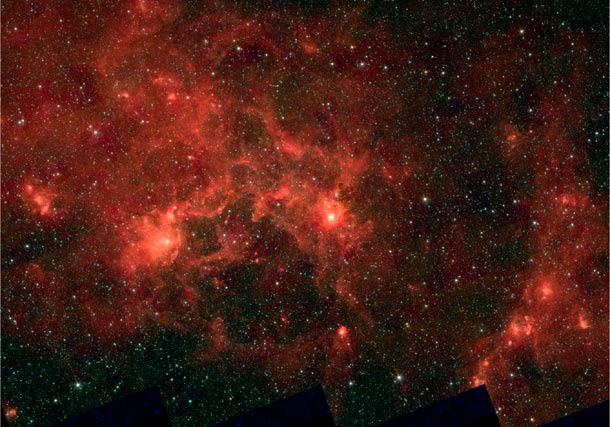Create a free profile to get unlimited access to exclusive videos, sweepstakes, and more!
Desktop Project Part 5: The mighty, mighty Dragonfish

[Over the past few weeks, I've collected a metric ton of cool pictures to post, but somehow have never gotten around to actually posting them. Sometimes I was too busy, sometimes too lazy, sometimes they just fell by the wayside... but I decided my computer's desktop was getting cluttered, and I'll never clean it up without some sort of incentive. I've therefore made a pact with myself to post one of the pictures with an abbreviated description every day until they're gone, thus cleaning up my desktop, showing you neat and/or beautiful pictures, and making me feel better about my work habits. Enjoy.]
I'm fond of saying that the Orion Nebula is one of the biggest, most active star forming regions in the Milky Way galaxy. It has enough gas to form thousands of stars like the Sun, and it's one of the brightest and closest such gas clouds in the sky.
But, it turns out, Orion is a piker. Or a pike. Because behold: The Dragonfish Nebula!
[Click to ennebulenate, or if you're feeling frisky, grab the huge 7000 x 5500 pixel 26 MB version!]
The Dragonfish nebula -- named for its resemblance to a terrifyingly toothy deep-sea fish -- is, like its namesake, a monster. It's something like 450 light years across... compare that to the Orion Nebula's 12-15 light year width and you start to see how huge this thing is. It's also incredibly massive: it may have a total mass exceeding 100,000 times the Sun's mass, and may contain millions of stars!
Incredible. Even from other galaxies, it must be one of the most obvious features in the Milky Way. Yet, ironically, it's very difficult to see at all from Earth. It's located over 30,000 light years away, on the other side of the galaxy. There's a vast amount of interstellar material (like dust) between us and it, absorbing its light, so in optical light it's essentially invisible. But infrared light can pierce that fog, and the image above was taken using NASA's Spitzer Space Telescope, designed to look in the infrared.
Astronomers used a different infrared telescope to look at the individual stars in the nebula, and found that it has an incredible 400+ O-type stars, the most massive stars that can exist. These stars are young, hot, massive, and blast out ultraviolet light. That's what's making this huge gas cloud glow, and in fact the cloud is expanding under the influence of the terrible flood of radiation. Worse, those stars will eventually explode in the next million years or so, one after another, blasting out radiation and material that will dwarf even what they're putting out now. That will eventually tear through the nebula, ramming it, causing parts of it to collapse and form new stars, and other parts to dissipate entirely.
We're safe where we are, tens of thousands of light year away. Too bad! In a million years, that'll be quite a show. Image credit: NASA/JPL-Caltech/Univ. of Toronto
Related Posts:
- A new old view of an old friend
- The unfamiliar face of beauty
- The gorgeous birth pangs of young stars
- Angry nebula is really REALLY angry



























